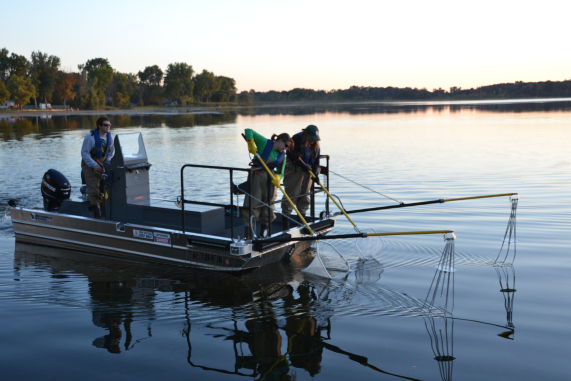Researchers channel Zeus to collect fish data
Add Summary

Joe Nohner is a CSIS PhD student who's studying largemouth bass, specifically how habitat helps baby largemouth survive and grow, and the socioeconomic factors that influence landowners’ habitat management choices. He's also a passionate fisherman who aims to understand the layers and layers of complexity to solve ecosystem problems. This is an excerpt from Joe's blog, Fishing for Habitat.
May 29, 2014
“The juice is on!” I shouted over the roar of the generator. As the words left my mouth orchestrated chaos erupted in front of me. Nine-foot nets plunged into the water, scooping largemouth bass as they arched  toward the surface in front of our boat.zeuslig2 Nets swung into the waiting hands of another researcher, transferring stunned fish into the livewell before technicians returned their focus to the water in front of our boat.
toward the surface in front of our boat.zeuslig2 Nets swung into the waiting hands of another researcher, transferring stunned fish into the livewell before technicians returned their focus to the water in front of our boat.
Electrofishing may be one of the most adrenaline-packed moments in the professional life of a fisheries biologist. The technique is used to capture fish by temporarily stunning them with electricity, and can be astonishingly adaptable and effective.
While the technique has been in existence since 1883, its popularity for scientific collection began in 1974 when researchers from the University of Wisconsin created the first boat-mounted electrofishing system. Even as the technology celebrates its fortieth birthday this year, new applications and techniques are constantly emerging.

The principle behind electrofishing is simple. Two electrodes, one negative (anode) and one positive (cathode) are placed in the water, and the difference in voltage between the electrodes generates an electrical field. As electricity passes between the electrodes it also passes through fish in the water column. When performed correctly electrotaxis occurs as the fish’s muscles involuntarily contract. Closer to the electrode the electrical field becomes more concentrated, and fish are immobilized in a state of muscle contraction called tetany. After recovery in a livewell most fish can be released with no serious injuries.*
The above is an excerpt from my Freshwater Electrofishing article in the most recent edition of Spotlight magazine. Follow the links to read the full article or learn about more research that Fisheries and Wildlife students at Michigan State students are conducting.
*Additional edit: I’ve received questions on whether fish experience pain during electrofishing. Fish do experience exhaustion equivalent to prolonged physical exertionb during electrofishing (because in essence the electricity causes their muscles to contract and relax rapidly) as well as less common other effects. To my knowledge there is no empirical evidence that fish experience pain the way we do at all (Rose et al. 2014 translated into plain english here) much less during electrofishing. In fact, pulsed electric fields are sometimes used for sedation. In addition to the classic text by Reynolds cited in my article, see Mitton and McDonald 1994.



 Print
Print Email
Email





